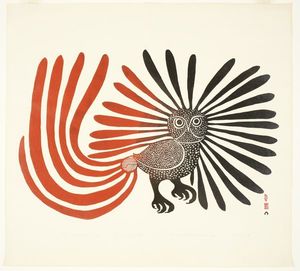Curator Jocelyn Piirainen on the AGO's Tunirrusiangit, featuring Iconic Inuit Artists Kenojuak Ashevak & Tim Pitsiulak
This summer, the Art Gallery of Ontario is celebrating two extraordinary Inuit artists: Kenojuak Ashevak and her nephew Timootee (Tim) Pitsiulak. The exhibition, Tunirrusiangit: Kenojuak Ashevak and Tim Pitsiulak, runs until August 12 and features 111 pieces, including Ashevak's iconic "The Enchanted Owl".
We're excited to speak today with curator Jocelyn Piirainen, who is also a contributor to Tunirrusiangit (Goose Lane Editions), which includes 60 pieces of the artists' work alongside essays on the past and future of Inuit identity. The book was published to coincide with the AGO's exhibition, which is the first time Inuit art has been showcased in the AGO’s largest exhibition space.
Jocelyn tells us why Tunirrusiangit is the right name for both the book and the AGO's showcase, shares her thoughts on Pitsiulak's innovative use of technological elements in his artwork, and attempts the tough task of choosing a favourite piece from the exhibition.
Don't miss the chance to see these gorgeous pieces for yourself at the AGO before August 12.
Open Book:
How did you first encounter Pitsiulak and Ashevak's work? What would you love for new fans of their art to know about each of them?
Jocelyn Piirainen:
I first came across their work a few years ago as I worked for a while at an inuit arts shop, selling carvings and prints. I would want new admirers of their work to look at the detail in their drawings, how much imagination these two both had!
OB:
Tell us a little bit about your essay and the other essays in the book. How were they selected and what do you hope readers will be able to learn from them?
JP:
My essay is more of a personal reflection on the process of putting this exhibition together – having the opportunity to collaborate with the Art Gallery of Ontario as well as with the other Inuit artists/curators. The other texts also come from the other Inuit artists/curators – Laakuluk Williamson Bathory, Taqralik Partridge and Koomuatuk Curley. Laakuluk and Taqralik both are gifted in words and poetry. Reading their texts and poems is simply wonderful! Koomuatuk’s excerpt discusses the importance of hunting in all aspects of the lives of Inuit. Tim Pitsiulak was very much both a hunter and an artist.
OB:
Why is Tunirrusiangit the right name for this book (and the exhibition)? How do you see the word and its meaning reflected?
JP:
In Inuktitut, tunirrusiangit roughly translates to their gifts. For us inuit curators, we felt that the artists were both challenging us but also giving us their gifts of their artwork. The exhibition, as well as the book, were our responses to their artwork and accepting their gifts.
Your CanLit News
Subscribe to Open Book’s newsletter to get local book events, literary content, writing tips, and more in your inbox
OB:
The Tunirrusiangit exhibition will be the first time Inuit art has been showcased in the AGO’s largest exhibition space. What does this milestone mean to you?
JP:
Personally, it is a huge milestone – both as a curator and as an inuk. This is only my second exhibition that I have curated, and to be working with the Art Gallery of Ontario is an honour. As an inuk, it also meant creating more of a connection with my culture and roots. I am grateful of the time that I spent with my fellow Inuit curators and other Inuit that I have met from this opportunity.
OB:
Pitsiulak's work often incorporates technology alongside more traditional elements. How do you see the role of technology functioning in his art?
JP:
I see technology in his work as being another tool – but also as something that he sees in everyday life. He would use a GoPro camera to capture images underneath the water – and would then draw those images, creating large and detailed drawings. Alongside some of the traditional imagery though, I see it as a connection between the modern age and the past – that there are still Inuit traditions and ways of being that are still alive today in this modern age.
OB:
What are a couple of your personal favourite pieces amongst the 111 included in Tunirrusiangit?
JP:
This is a tough question since they are all so amazing! Of Kenojuak’s – it would be her “Nighthawk”. I love the detail and colours – and the expressive face of this hawk! Of Tim’s work, it would be the “Three Cranes”. Not many would think about seeing cranes in the north, and I love their expressive quality as well.
_______________________________________
Tunirrusiangit is organized by the Art Gallery of Ontario in partnership with Mobilizing Inuit Cultural Heritage, with the support of Dorset Fine Arts, a division of the West Baffin Eskimo Co-operative.



